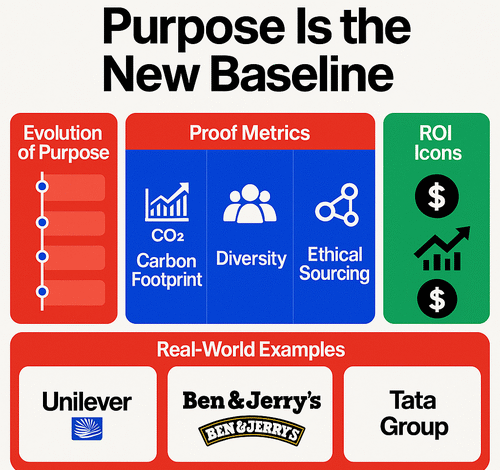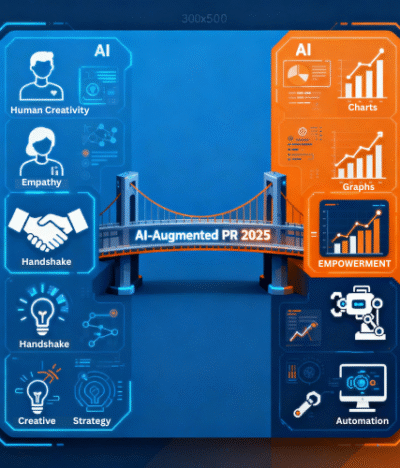What Is Brand Purpose, Really?
A decade ago, brand purpose was a differentiator — a noble statement that set a company apart from its competitors.
In 2025, it’s the opposite. Purpose is now table stakes. Consumers expect the brands they support to stand for something real, measurable, and aligned with their values.
The conversation has shifted from “What do you sell?” to “What do you stand for?”
And in this new reality, brands that fail to connect their mission to meaningful action risk becoming irrelevant.
What Is Brand Purpose, Really?
Brand purpose is more than a tagline or CSR campaign — it’s the reason your brand exists beyond profit. It defines how your company contributes to society, how it treats people and the planet, and how it uses its influence for positive change.
In simple terms: it’s the why behind the what you sell.
The Evolution of Purpose
- 2010s: Purpose as PR — used to generate goodwill and differentiation.
- 2020s: Purpose as strategy — woven into every business decision.
- 2025 and beyond: Purpose as proof — measurable, transparent, and accountable.
Brands today are judged not just by what they say, but by what they show.
Why Brand Purpose Is Now Non-Negotiable
1. Consumer Expectations Have Changed
Modern consumers, especially Gen Z and Millennials, buy with their values. According to Edelman’s 2025 Trust Barometer, over 70% of people believe brands must take a stand on social or environmental issues.
A strong brand purpose signals alignment — it tells consumers, “We believe what you believe.” Without that connection, even the best product can feel empty.
2. Employee Engagement Depends on It
Purpose isn’t just external. Internally, it drives motivation, retention, and innovation.
Employees want to work for organizations that reflect their values. When purpose is clear, teams feel empowered to contribute meaningfully — transforming workplaces into communities with shared vision.
3. Investors Are Watching
Purpose has become an investment metric. ESG (Environmental, Social, Governance) frameworks are now mainstream in evaluating long-term business sustainability.
In short: purpose drives trust — and trust drives capital.
From Mission Statements to Measurable Metrics
Having a mission statement is no longer enough.
The next evolution of brand purpose is accountability — proving impact through data, transparency, and action.
1. Purpose-Driven KPIs
Brands are now tying their purpose to measurable outcomes:
- Reduction in carbon footprint
- Percentage of profits reinvested in community programs
- Employee diversity ratios
- Ethical sourcing compliance
These aren’t side projects — they’re part of how success is defined.
2. Authentic Storytelling Through Data
Storytelling remains powerful, but audiences now want proof.
For example, Patagonia doesn’t just say it supports sustainability — it publishes annual environmental impact reports.
When purpose meets transparency, trust follows naturally.
3. Integrating Purpose into Product
The most forward-thinking companies are embedding purpose into their offerings.
Take Dove’s “Real Beauty” platform — it’s not just a campaign; it’s part of the brand DNA reflected in every touchpoint.
Purpose works best when it’s lived, not labeled.
Real-World Examples of Purpose in Action
-
Unilever : Unilever’s “Sustainable Living Brands” now account for 60% of its growth, demonstrating how clear purpose can drive profitability.
Its success shows that purpose and performance aren’t opposites — they’re partners. -
Ben & Jerry’s: By taking public stands on climate justice and racial equity, Ben & Jerry’s has proven that purpose-led activism builds both advocacy and loyalty.
- Tata Group: In India, Tata’s long-standing commitment to community development and ethical governance shows how brand purpose rooted in legacy can sustain relevance for decades.
The ROI of Purpose: Beyond Goodwill
A clear brand purpose creates measurable business outcomes:
- Brand Loyalty: Customers return to brands that reflect their beliefs.
- Crisis Resilience: Purpose-driven brands recover faster from PR or market setbacks.
- Differentiation: In crowded markets, authenticity becomes your edge.
- Long-Term Profitability: Purpose aligns business sustainability with societal value.
Purpose isn’t a cost — it’s a growth engine.
The Future: Purpose with Proof
In 2025 and beyond, brand purpose will be defined not by how well it’s written, but how well it’s measured.
AI, data analytics, and sustainability tracking will make it easier than ever for brands to quantify their societal impact and demonstrate progress publicly.
The winning brands won’t just “stand for something.” They’ll prove it — consistently, transparently, and authentically.
Conclusion: From Words to Worth
The age of performative purpose is over.
To remain credible and competitive, brands must move from mission to metrics — connecting purpose to measurable impact and business outcomes.
In a world where consumers demand meaning and proof, brand purpose is no longer a nice-to-have — it’s the baseline for trust, loyalty, and long-term success.
The question is no longer “Do you have a purpose?”
It’s “Can you prove it?”



